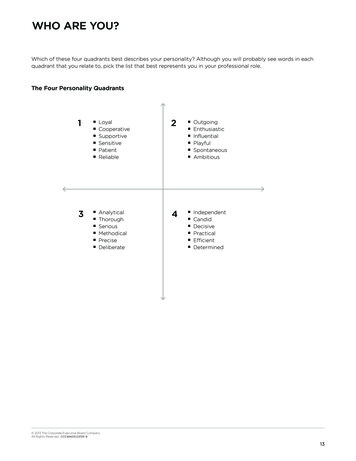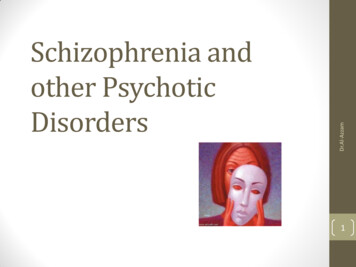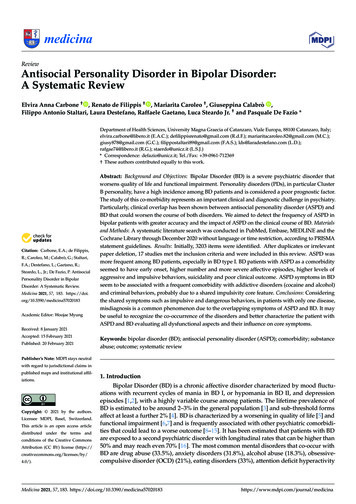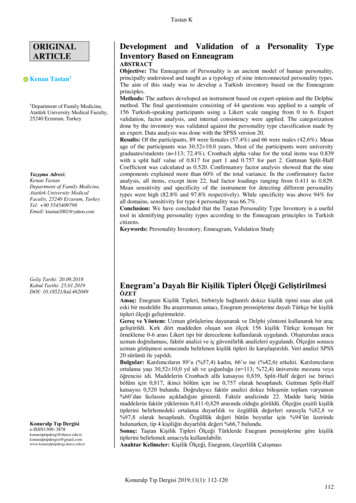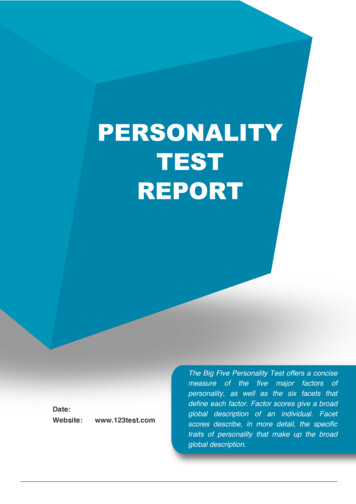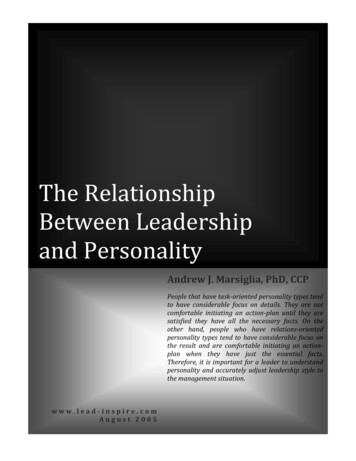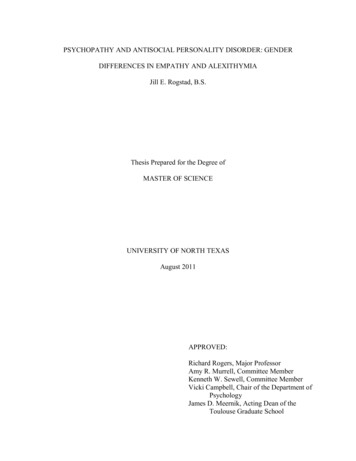
Transcription
Personality DisordersDSM-IV Axis II Personality disorders are enduring patterns ofperceiving, relating to, and thinking about theenvironment and oneself that:are exhibited in a wide range of social andpersonal contextsare inflexible and maladaptivecause significant functional impairment orsubjective distressPSYC 163Spring2010Diagnostic Criteria General Diagnostic Criteria for a Personality DisorderA. An enduring pattern of inner experience and behavior thatdeviates markedly from the expectations of the individual’sculture in two or more of the following areas:1. Cognition2. Affectivity3. Interpersonal functioning4. Impulse controlDiagnostic CriteriaThis enduring pattern:B. is inflexible and pervasiveC. leads to significant distress or impairmentD. is stable and of long durationE. is not better accounted for by another mental disorderF. is not due to direct physiological effects of a substanceStatisticsDisorderPrevalence(general population)Gender difference(clinical population)Paranoid personality disorder2.3% - 2.4%More malesSchizoid personality disorder1.7% - 4.9%More malesSchizotypal personality disorder0.6% - 3.3%More malesAntisocial personality disorder0.7% - 1.0%More malesBorderline personality disorder0.7% - 1.6%More femalesNo differenceHistrionic personality disorder 2%Narcissistic personality disorder0.1%More malesAvoidant personality disorder5.0% - 5.2%No differenceDependent personality disorder0.6 - 1.5%No differenceObsessive-compulsive personality disorder2.0% 0- 2.4%More males
Gender biasKind vs. Degree Categorical versus Dimensional Models DSM-IV: the categorical perspective that PersonalityDisorders represent qualitatively distinct clinical syndromes. Alternative approach: The dimensional perspective thatPersonality Disorders represents maladaptive and extremevariants of personality traits that many of us experiencetemporarily or to a lesser degree.PD Clusters DSM-IV-TR Personality Disorder ClustersClusterCharacteristicsPersonality DisorderOdd or EccentricParanoid, Schizoid,SchizotypalBDramatic, Emotional, orErraticAntisocial, Borderline,Histrionic, NarcissisticCAnxious or FearfulAvoidant, Dependent,Obsessive-CompulsiveACluster A:Paranoid PD Characterized by:A pattern of pervasive andunjustified distrust andsuspiciousness of others,beginning by earlyadulthood and present in avariety of contexts.
Paranoid PD: Diagnostic features Pervasive distrust and suspiciousness of others. Preoccupation with unjustified doubts about the loyaltyof friends or others. Tendency to read hidden demeaning or threateningmeanings into benign remarks. Bearing persistent grudges over insults. Recurrent suspicions, without justification, regarding thefidelity of spouse or sexual partner. Does not occur exlusively during the course ofschizophrenia or another psychotic disorder.Paranoid PD: Diagnostic features Differential Diagnosis Paranoid PD can be distinguished from Schizophrenia(Paranoid Type) and Mood Disorder with Psychotic Featuresbecause these disorders are all characterized by a period ofpersistent psychotic symptoms - to give Paranoid PDdiagnosis the disorder must have been present before theonset of psychotic symptoms and must persist when theseare in remission. The disorder must also be distinguished from personalitychange due to a general medical condition or fromsymptoms that develop due to chronic substance abuse.Paranoid PD: Causes & Treatment Causes Biological and psychological contributions are unclear. May result from early learning that people and the world is adangerous place (which leads to maladaptive vigilance). Treatment Few seek professional help on their own. Treatment focuses on the development of trust. Cognitive therapy to counter negative thinking. Lack of good outcome studies.Cluster A:ParanoidSchizoid P.D.PD Characterized by:A pervasive pattern ofdetachment of (and lack ofenjoyment of) socialrelationships and arestricted range ofexpressions of emotions,beginning by earlyadulthood.
Schizoid PD: Diagnostic features Pervasive pattern of detachment from social relationshipsand a restricted range of expression of emotions,beginning by early adulthood. No desire for social relationships and lack of ability toform close social relationships Often single, with little interest in sex or intimacy Preference for solitary activities Often appear indifferent to compliments and criticisms Find little or no joy in activities Does not occur exclusively with schizophrenia oranother disorder.Schizoid PD: Causes & Treatment Causes Childhood shyness a precursor? Preference for social isolation in schizoid personalityresembles autism. Poor social skills training? Treatment Few seek professional help on their own. Treatment focuses on the value of interpersonalrelationships, empathy, and social skills. Treatment prognosis is generally poor.Cluster A:Schizotypal PD Characterized by:A pattern of interpersonaldeficits featuring acutediscomfort with closerelationships, as well ascognitive and perceptualdistortions andeccentricities of behavior.Schizotypal PD: Diagnostic features Acute discomfort with close interpersonalrelationships (as opposed to a lack of interest),cognitive and perceptual distortions, andeccentricities of behavior, beginning by earlyadulthood. Odd or eccentric behavior or appearance (e.g.,mumbling; odd dress) Often misinterpreting casual incidents as havingparticular or unusual meaning for themselves Odd beliefs or magical thinking that influencesbehavior and is inconsistent with subcultural norms. Suspicious and paranoid thoughts
Schizotypal PD: Diagnostic features Express little emotion or inappropriate emotion. Unusual perceptual experiences, includingillusions. Odd thinking or speech. Does not occur exclusively with schizophrenia oranother disorder.Schizotypal PD and other disorders 30% - 50% of individuals diagnosed with schizotypal PDhave a concurrent diagnosis of Major DepressiveDisorder when admitted to a clinical setting. Considerable co-occurrence with Schizoid, Paranoid,Avoidant, and Borderline Personality Disorders. Social isolation and restricted affectivity are common toSchizoid, Schizotypal, and Paranoid PDs, but Schizoid PDcan be distinguished from Schizotypal PD by the lack ofcognitive and perceptual distortions and from ParanoidPD by the lack of suspiciousness.Schizotypal PD: Causes & Treatment Causes A phenotype of a schizophrenia genotype? Evidence of some damage to the left hemisphere and moregeneralized brain abnormalities. Treatment Main focus is on developing social skills. Treatment also addresses co-morbid depression. Medical treatment is similar to that used for schizophrenia. Treatment prognosis is generally poor.Identify the Personality Disorder Theo is quite a loner. He walks to class by himself, does not talk toanyone and appears indifferent to other people. It is clear that Theoneither desires nor enjoys closeness with others. He does not actin any obviously unusual ways nor does he appear to possessstrange beliefs about the world. You are waiting to board a plane when you hear that the flight hasbeen delayed due to a passing thunderstorm. The man sitting next toyou says, "Passing thunder storm, sure! That's Jim again, he's beendoing everything to make me miss this meeting because he's trying toget me fired!"
PD Clusters DSM-IV-TR Personality Disorder ClustersClusterCharacteristicsPersonality DisorderOdd or EccentricParanoid, Schizoid,SchizotypalBDramatic, Emotional, orErraticAntisocial, Borderline,Histrionic, NarcissisticCAnxious or FearfulAvoidant, Dependent,Obsessive-CompulsiveACluster B:Antisocial PD Characterized by:A pervasive pattern ofdisregard for, and violationof, the rights of others thatbegins in childhood orearly adulthood.(“social predators”)ClusterA: PD:AntisocialSchizotypalWarning P.D.signs Defiance and disregard for social norms or therights of other people Regularly performing illegal acts Show little empathy for others Lack of remorse for persons they have hurt Tendency to be self-absorbed Often appear superficial Show difficulties in fulfilling responsibilities andcommitmentsAntisocial PD: Warning signs Habitually lying or being manipulative Use of aliases and conning people for personalprofit or pleasure Frequent physical aggression and conflict withother people Having had serious behavioral problems inchildhood Blaming others or offering rationalizations forantisocial behavior Impulsive behavior
Antisocial PD: DSM-IV CriteriaA. Pervasive pattern of disregard for and violationof the rights of others since age 15, indicated bythree or more of the following:1. Failure to conform to social norms2. Deceitfulness3. Impulsivity or failure to plan ahead4. Irritability and aggressiveness5. Recklessness6. Recklessness7. Lack of iteriaB. Individual is at least 18 years old.C. Evidence of Conduct Disorder before age 15.D. Occurrence of antisocial behavior is notexclusively during the course of Schizophrenia or aManic Episode.Antisocial PD and Psychopathology Alternative labels and Diagnostic Criteria:The Cleckley/Hare Psychopathology criteria DSM-IV Antisocial PD criteria: focus onobservable behaviors. Cleckley/Hare Psycopathology criteria: focus onunderlying personality traits.Antisocial PD and Psychopathology Hare Psychopathology Checklist (Psychopathpersonality profile): Glibness/superficial charm Lack of realistic, long-term plans Impulsivity and irresponsibility Grandiose sense of self-worth Need for stimulation/proneness to boredom Pathological lying Conning/manipulative
Antisocial PD and Psychopathology Hare Psychopathology Checklist (continued): Lack of remorse of guilt- callous and lackingempathy Shallow affect Parasitic lifestyle Poor behavior controls Promiscuous sexual behavior Early behaviorAntisocial PD and Psychopathology Antisocial PD, Psychopathology, and CriminalityPsychpathologyAntisocial PDCriminalityAntisocial PD: Causes Causes: Genetic Contributions Family, twin, and adoption studies suggest a geneticinfluence on both Antisocial PD and criminality. Gene-environment interaction. Integrative Model: the important element is thatbiological, psychophysiological, and cultural factorscombine in intricate ways to create someone likeGeorge.Antisocial PD: Causes Causes: Neurobiological Contributions The Underarousal Hypothesis - Cortical arousal is toolow. The Cortical Immaturity Hypothesis - Cerebral cortex isnot fully developed. The Fearlessness Hypothesis: Psychopaths fail to respondwith fear to danger cues.
Antisocial PD: Treatment Few seek treatment on their own Antisocial behavior is predictive of poor prognosis, evenin children Emphasis is placed on prevention and rehabilitation Incarceration is often the only viable alternativeCluster B:Borderline PD Characterized by:A pervasive pattern ofinstability of interpersonalrelationships, self-image,and affects, and controlover impulses that beginsby early adulthood.Borderline PD:SchizotypalDiagnosticAntisocial featuresPDP.D. Frantic efforts to avoid real or imaginedabandonment. A pattern of unstable and intense interpersonalrelationships: alternating between extremes ofidealization and devaluation. Unstable self-image or sense of self Impulsivity in areas that are potentially selfdamaging (e.g., spending, sex, substance abuse,reckless driving, binge eating) Recurrent suicidal behaviors or threats, or selfmutilation.Borderline PD: Diagnostic features Affective instability and reactivity (e.g., intenseepisodic dysphoria, irritability, or anxiety usuallylasting a few hours and only rarely more than a fewdays) Chronic feelings of emptiness Inappropriate, intense anger or difficultycontrolling anger (e.g., frequent displays of temper,constant anger, recurrent physical fights) Transient (brief) stress-related paranoid ideationor severe dissociative symptoms
Borderline PD: Diagnostic featuresMnemonic for some features of Borderline PD: PRAISE Paranoid ideas Relationship instability Angry outbursts, affective instability, abandonment fears Impulsive behavior, identity disturbance Suicidal behavior EmptinessBorderline PD: Causes & Treatment Causes Borderline PD more prevalent in certain families andlinked to mood disorders - genetic influence? Psychosocial influence: possible contribution of earlytrauma? Parallels between PTSD and borderline PD. Treatments Antidepressant medications provide some short-termrelief. Dialectical behavior therapy is the most promisingpsychosocial approach.Summary General Definition: Enduring and relatively stable ways ofthinking, feeling, and behaving. Disagreement over how to categorize personality disorders. DSM-IV (categorical approach): Includes 10 personalitydisorders, each falling into one of three clusters. It is difficult to pinpoint the causes of personality disorders. It is often difficult to treat personality disorders.
Paranoid personality disorder 2.3% - 2.4% More males Schizoid personality disorder 1.7% - 4.9% More males Schizotypal personality disorder 0.6% - 3.3% More males Antisocial personality disorder 0.7% - 1.0% More males Borderline personality disorder 0.7% - 1.6% More females Histrionic
